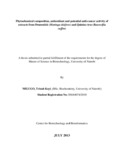| dc.description.abstract | This study had the aim of phytochemically evaluating the usefulness of two plants (Moringa oleifera and Rauwolfia caffra), used in traditional health care to manage cancer and diseases related to oxidative stress. To achieve this, the leaves of M. oleifera and the leaves and stem bark of R. caffra were extracted with different solvent systems and subjected to Radical Scavenging Activity (RSA) assay to determine the level of antioxidant activity. Establishing the antioxidant activitiy of the extracts of the two plants is important since strong antioxidants are normally associated with the prevention of cancer.
RSA was assessed using 1, 1-diphenyl-2-picrylhydrazyl (DPPH) method and the commercially available quercetin was used as a positive control. The 50 % CH2Cl2: MeOH extracts of the stem bark of R. caffra exhibited the highest RSA of 96.03 % at 0.2 mg/ml while the MeOH extract of the leaves of M. oleifera showed RSA of 83.84 % at 0.2 mg/ml. The R. caffra stem bark fractions obtained by fractionation of the total extract (CH2Cl2: MeOH; 1:1) revealed possible antagonistic effect in at least two classes of secondary metabolites: co-occurrence of alkaloids and saponins reduced antioxidant activity (all phytochemicals = 58 %; alkaloids only = 63 %; alkaloids plus saponins = 15 %). However, synergistic activity was observed for a combination of steroids, terpenoids and cardiac glycosides, but without alkaloids (82 %).
Anti-poliferative activity was assessed using crystal violet assay where human hepatocellular carcinoma (Liver cancer; Hep-G2) and rhabdomyosarcomas (Muscle cancer; RD) were used as model cell lines, while Vero cells were used as control, and to test for possible cytotoxicity to normal cells. The MeOH extract of the leaves of M. oleifera displayed significant anti- proliferative activity (p < 0.05) against Hep-G2 and RD cell lines with limited activity on Vero cells. Comparatively, proliferation of RD cell lines was more affected than Hep-G2. The 50 % MeOH/CH2Cl2 extract of the stem bark of R. caffra did not show significant activity against proliferation of RD and Hep-G2 cells, but it exhibited activity against proliferation of Vero cells.
Overally, M. oleifera leaf extracts were less toxic and displayed anti-proliferative activity while extract of the stem bark of R. caffra was not target specific. However, the latter exhibited significant antioxidant activity. The usefulness and risk levels associated with drumstick and
quinine tree; plants used in traditional medicine to manage cancer and diseases related to oxidative stress, require further investigation as the solvent systems used in this study, may not exactly mirrow those used by traditional healers. Phytochemicals have been shown to act in a solvent specific manner. | en |

